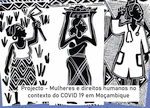Sexuality: A Male History
Conceição Osório
This article aims at discussing the concept of sexuality through the presentation of several ongoing theoretical discussions. It is the product of a reflection done during the execution of a research pilot study on gender identities and sexuality1. The title summarises the issues put forward by the social sciences in the analysis of the sexual dimension in the construction of social identities, namely the rupture with the hegemony of the biologist perspective. The reduction of sexuality to anatomic factors, which up to the second half of the 20th century dominated the studies on the representations and differentiated behaviours of women and men, was based on the transposition of the sexual difference to the social area, hiding the processes and mechanisms that modelled persons of different sex into inequality.
This article aims at showing the contribution of academic feminism to a reinterpretation of sexuality, with an interaction of theoretical areas and laying bare, through an analysis of discourses and social practices, the domination of an androcratic vision which continues to guide and structure scientific language and thought.
The concept of sexuality
Today there is no single concept of sexuality. The dependence on the methodological structure of the various sciences and their historical “occultation” has not allowed the construction of an “ideal type” that could reflect on the various realities. In many sciences, such as medicine, sexuality is used in a utilitarian and practical sense, mainly concerned with establishing relations between diseases, namely HIV/AIDS, and the behaviours of individuals. In others, sexuality is reduced to a dimension of identity, and is not taken as an object of study, with conceptual instruments and methodologies that allow through its “isolation” to study and grasp all its plurality and complexity. The feminist studies, although also debtors to the specifities of the various areas, have contributed to its restitution to history, considering it simultaneously the result and the regulating agent of order (Heilborn, 1999).
The studies with/on the gender concept (which precede those of sexuality) have allowed an interpretation of reality at the level of the structuring inequalities, of the social relations between women and men, broadening the study on identities and creating new assumptions and paradigms. It is the case of the research on sexuality, which in the years 90 of the previous century started to incorporate the notion of sexuality into the theoretical debate as the basis of identities, which until then was limited to a biological, and essentialist interpretation. That means, sexuality does not only mean practices related to reproduction and the use of sex, but corresponds to and results from cultural models which impose a normative pattern subject to social vigilance and sanctions (Vance, 1995; Foucault, 1975). If in this sense sexuality is not universal, because it is not biologically determined, it is however, if we take a gender analysis into consideration, susceptible to some generalisation, insofar as male domination is transversal to the cultures and histories of societies.
With the progress of HIV/AIDS studies and the search for explanatory models for the successes and failures of the epidemic prevention campaigns and considering the multiplicity of ways to look at the problem, the need to tie the analysis of sexuality to gender systems becomes increasingly more evident. This means that the sexual experiences of women and men respond to differentiated needs and objectives, which not only lead to differentiated social expectations, but also shape roles, functions and how these are socially classified (Heilborn, 1999).
Sex is, thus, always social, while even biological sex is a scientific construction rooted in inequality, as demonstrated by medicine and biology when analysing in the cells the identifying ideological traces of the sexual difference – the male chromosome as “active” and the female one as “passive”, or the simple fact of defining the female as the absence of the male. Our understanding of the world and our conceptualisation is related to this sexual bipolarisation: culture is male, nature is female, economy is male, consumption is female; the male indicates power, the female lack of power (Laqueur, 1994).
As said before, the theoretical debate about sexuality has been held around two positions: essentialism (sexuality is either limited to a physiological mechanism in the service of reproduction, or is a manifestation of a psychic drive) and constructivism (which seeks to put sexuality in the perspective of cultural production in distinct historical spaces and times) (Heilborn, 1999). It is this last approach which has inspired the feminist theory of difference, which when emphasizing inequality as structuring social relations between the two sexes, claims women’s right to difference. With the argument that difference may lead to essentialism, this approach is beginning to be questioned. However, if it is certain that the essentialist theory makes the rights of “human nature” dependent on non-difference, conforming women to the male functions and model, denying them, namely, the specificity of their sexuality and sending them off to, for example, non-maternity, may, in fact, produce mechanisms of conformity with social norms imposed by patriarchy. This analysis would further the emptying of the gender concept, taking the struggle for equality only in its more formal aspects. This is what happens with Marxist feminism (rooted in the 19th century) which, adopting class as the only legitimate concept to analyse social inequalities, ends up hiding the unequal and hierarchically male structure of societies. To talk about difference is, therefore, not at all essentialist (in which this presupposes as natural and irreducible), but corresponds on the contrary to differentiation processes that result from differentiated historical and cultural experiences.
From the point of view of the social sciences, sexuality as a sphere of life depends on socialization, the learning of social rules that allow a legitimate exercise of sexual activities. Thus, the sexual realm is not limited to the reproductive and psychic dimension. Although it is assumed that the models of interpretation in the area of the production of knowledge on social reality vary according to the object and methodology of each one of the disciplines, it is in this context of analysis that the majority of feminist academics view sexuality as construction, both as dependent on factors that can be understood and dealt with separately, and in the inter-relation with other scientific phenomena or areas (Loyola, 1999). In this line of thought two approaches to sexuality stand out: autonomist constructivism in which sexuality appears as an autonomous category “detached” from other systems and subsystems of social reality and relational constructivism which, through the observation of differentiated experiences between women and men, seeks to establish the underlying principles of inequality and their relation with other social dimensions (Vance, 1995). From the point of view of anthropological analysis, some authors analyse the construction of masculinity and femininity from the rupture with the idea, which confers reasoning to human nature for the existence of (hierarchically classified) differentiated attributes of women and men (Lagarde, 1997).
Foucault’s studies focus on the analysis of sexuality through “the knowledge produced about it, the power systems that regulate its practice and how individuals may and should recognise themselves as subjects of this sexuality” (Foucault, 1986: 8) and question the static vision of the phenomenon, allowing the opening up of a line of research which confers a central role to sexuality for the understanding of identities. This approach, laying bare systems of domination previously hidden by the naturalist conception of social organisation, namely of reproduction, not only relates such diverse fields as the political, the cultural and the economic field, but also revolutionizes the theories of power. This becomes a constitutive element of the spaces where norms and practices of social control are produced which, aiming at the maintenance of order or the positive appropriation of disorders, have in sexuality a central dimension.
In the current context of the struggle for sexual and reproductive rights, it is interesting to highlight the appearance of new control mechanisms of female sexuality in contemporary societies. For example, in Mozambique, if in the rural societies the relation between sexuality and reproduction (the absence of sexual intercourse during breast feeding presupposes the negation of sexuality of the woman as a subject) is still evident, in the urban areas the maternal function of the female body assumes great symbolic value: as having more possibilities of power over their own body, through birth control, family planning or through clandestine abortion, women may theoretically no longer be conditioned by the life cycle which constrains them to maternity; however, this continues being the central attribute of female identity. This situation is clearly visible in the area of political power, where women find their capacity of intervention optimised (and socially recognised) when dealing with issues related to reproduction, biological reproduction as well as the reproduction of the cultural, social and political model.
Through the concept of habitus2, Bourdieu (1995) seeks to demonstrate how the “in-corporation” of the structures of male domination into the construction of identities is produced, both at the level of representations and practices, and of the mental structures that classify these representations and practices of female sexuality. It is in this context that the symbolic effectiveness of female subordination is expressed in the existence of discourses and points of view (resulting from the appropriation of the model) that aim at re-situating at each moment (through a “granted complicity”) the place of women and of men.
However, whichever is the approach, the body is the point of reference of analysis. The body reveals and transmits with great symbolic effectiveness the values and norms that guide the models of social, cultural and political hierarchization. In this sense, by offering the lessons learned, the body is an agent of culture. But it is also, as it is subject to social vigilance, a “practical place of control” (Bordo, 1988). This analysis has as its reference the work done by Bourdieu and Foucault in the area of the mechanisms of exercising symbolic and power violence as action on the behaviours of others. For these two authors, the body, the gestures and the feelings (in action and reaction) are organised as a function of the constraints that confine women and men in a totalitarian and unequal vision of social relations, aimed at hierarchizing roles and functions through sexual and reproductive control. Foucault (1975), when analysing the various forms of oppression of women’s bodies, refers even to the construction of “submissive bodies” on which the forces that model the identities converge.
It is from this point of view, in which power is a strategy of action on action that we can speak, among the age group of adolescents and youth3, of arrangements, more than of change of identity. Arrangements that find expression in ruptures, destabilization and new reappropriations of the cultural arrangements that may or may not lead to a questioning of the model of domination, in the sense of its destruction, as well as of its recomposition (insofar as one only seeks to respond to a crisis of the previous model, maintaining its bases unchangeable). In this line, some authors emphasize how the new information in interaction with affectivity may produce lessons and practices that allow changes in the habitus (Bauleo, 1974). The construction of subjectivity which is thus realised through individual and collective experience and the appropriation of social values should be understood, in the first place, in its articulation with social relations and, in the second place, with the capacity of the subjects to reinterpret domination and to act.
Sexuality and identity
The historical and founding character (as explanation of gender inequality) of sexuality is expressed in how in the course of time societies have been attributing identity characteristics to biological sex (Lagarde, 1997). When we look at a recent past, such as the 19th and 20th century, we see that diseases like hysteria, agoraphobia and anorexia, considered being female disorders, are ideological constructions of the typical femininity of these periods; these disorders are in agreement with a standardisation of female behaviour, as if the identity of women were mirrored by these diseases. Notions developed by the Freudian school describe femininity as passive, enchanting, emotionally unstable (hysteria) and capricious. Today, although there are only few studies on what is femininity, one notices that in the various artistic forms, often expressed through the common sense reflected in the “sentimental magazines”, an ideal of the female body directly related to its sexual function still continues. In the fifties agoraphobia represented the cultural stereotype of the sexual role of women (at home, in the kitchen, in bed) and the anorexia of the eighties presents a model of beauty, the more paradigmatic examples of which are the discourses about the “success achieved by slim women” and the culinary recipes and pharmaceutical prescriptions that aim at submitting the body of women to rules considered fundamental for their social recognition and inclusion (Bordo, 1988).
If we pay attention to what is happening today in Mozambique, it becomes evident that, for example, among young female university students, while they continues to favour the traditionally female virtues, they are also taught to incorporate a male language and male values, such as discipline and emotional control. The female bodies now talk about this need of women to acquire all best qualities of previous generations and all best characteristics, which men appreciate in men (Heilborn, 1999).
If it is true that today, as Foucault refers (1975), and contrary to what happened two or three centuries ago, one speaks about sex, in church, at school and in the reference environments, the aim is less to question the patterns of representation and their exercise, than to control (“to police” is the term used by the author) and regulate sexuality. In the wake of the Foucaultian interpretation, the feminist academics Marugán Pintos and Vega Solís (2001) broaden the debate on the relation between body and power. For the authors, the female body is the colonised body, a non-autonomous place where power is exercised and practised. As the body is the place that interprets, reinterprets, strengthens and practices the values of male domination, it is in her (as the struggle of women for their sexual rights advances) that power acts in a more aggressive way. It is no coincidence or just because there is a greater visibility of the violation of women’s human rights, that both in so-called more backward societies as in those of greater development, acts of violence against women are increasing, particularly violation and domestic violence. What is at stake, in fact, is the control of sexuality and the continuation of the subordinate female condition.
If sexuality is the result of appropriation by the subject of values and norms, the body, while it is an agent of culture, is also an object of construction, in the sense that it recreates and “operates on” the mechanisms that legitimise domination. So, the body articulates the private and the intimate with the social, and it is in it and through it that common knowledge, legitimated by scientific knowledge, means power. It is in this sense that some authors revisit the concept of social construction in which “the body appears as the interface between individuality, in which it is most unique, and the group, but also between the biological and the social” (Détrez, 2003: 4). The body is, in this way, a natural entity and a constructed entity, modelled by history, by culture and by gender. The differences in the process of socialization of girls and boys, through the knowledge taught in the family and at school reveal, thus, the social construction process of the anatomy of the sexes.
The current representations of women’s sexuality continue to demonstrate that they are still being understood only in their reproductive aspect (heterosexual = natural = non-sexuality). Since ancient times sexuality/ reproduction has been an obligatory binomial regulating sexual activity of decent women (the same does not happen to men who can exercise sexuality without a procreating objective). The fact that sexuality without reproduction is accepted for prostitutes and for older women does not mean that these have a right to their own sexuality, but that their sexuality is put at the service of male pleasure. If already in ancient Rome, Demeter, the mother, was presented and “classified” as the virtuous mother and woman contrary to the shameless women of Adonis, still today in many societies genital mutilation is considered a cultural manifestation, even in those societies that do not practise it and that assert themselves as defenders of women’s human rights. Thus, the control of reproduction only exists in the scope of the control of sexuality, that means, an unconstrained representation and exercise of sexuality constitutes a threat to the dominant cultural model.
Regarding the studies on the construction of sexual identities of youth, there are authors who, starting from the myths that are constructed about juvenile expectations, seek to reflect on the tendencies of universalising (through stereotypes) the construction of sexuality (Laire, 2001). This author refers to the ongoing mutation in the family organisation of modern and urban societies (e.g., monoparent families) which, when causing ruptures with previous values and norms, encourages an increase of the precariousness of the construction of juvenile identities.
Using the example of new youth communities (around the practice of sport, discos, Internet chats, etc.), Maffesoli (1995) is of the opinion that, given the temporal and fluid character of the environments to which they belong, the codes that structure the links between youths are marked by instability. It is in this sense that, considering the precariousness of these groups, the same author identifies rites (that may go from the vocabulary, the ways of dressing to the places they often visit) as “tribal” characteristics. For Maffesoli, the fact that the youth is simultaneously confronted with diverse values produced in different environments, leads to an identity construction (which is not more than seeking sense) that is realized in/with successive crystallizations, the nature of which is, as the author says, “volatile”. This volatile nature of the construction process itself is what others call “radical pluralism” which finds expression in the “radicalisation of the searches, in the adaptive flexibility and in the interchange of roles” (Laire, 2001).
In another perspective, the psychoanalysts highlight as central mechanisms in modern societies for an unequal construction of the identities of girls and boys the differentiated structuring of the personality of children of different sex, in which girls construct themselves in their relation with the mother (the self in relation) and boys through a process of individualization (Chodorow, 1984; Meler, 1996).
The studies on sexuality done on the African continent are object of analysis on the part of the Cameroonian sociologist Mburano Rwenge (1999). The main criticisms of the author refer to the fact that most of the studies only cover young students in the urban environment, their descriptive character and the absence of a more rigorous methodology, as is the case of inquiries that only allow getting unfounded generalizations. Analysing the research done the author observes the existence of three types of approaches to sexuality and sexual activity among the urban youth in Africa: the first one is what Rwenge classifies as socio-cultural, defending the relation between social destructuring (reflected in the absence of social control due to the destruction of traditional family structures) and the start of a premature and “uncontrolled” sexual life. The second perspective is the economic one, which relates sexual life, mainly of girls, to matrimonial strategy and poverty (“sugar daddy”). The third approach, not very characteristic of the continent, seeks to articulate the start of sexual activity with the importance that public policies confer to the situation of the youth. For the author, the factors of modernization, including the school, the media, social origin and the parents’ status are decisive variables in the construction of sexuality. The way in which these varied sources interact and communicate in the production of complementary values, influences the start of sexual activity as well as the construction of sexual identity among the youth of sub-Saharan Africa.
Also regarding the African continent, a series of texts have been produced recently aimed at reflecting, in a gender perspective, representations and the practice of sexuality. The analysis of the silence about sexuality constitutes an important contribution to an understanding of the mechanisms and arrangements that the “meeting” of cultures and oppressions have caused in the construction of identities, namely, Christianity, colonialism and the social function of women in African societies (Arnfred, 2004). If for this anthropologist there is, on the one hand, a relation between the religious Christian and colonial system and the patriarchal model, modelling the submission of women to Western values and imaginary, on the other hand, the issue of the social utility of the female body continues occupying a central place in the organisation of social roles of women. That means, the practice of sexuality is only legitimated and in this sense revealed when its aim is maternity.
This issue refers us once more to the material and symbolic importance of fertility as factor of social reproduction, a social reproduction materialized by the power exerted on and by the body of women: the silence about sexuality reveals, in fact, a deafening noise about gender domination. For example, in the case of Mozambique, fertility/infertility are criteria that classify not only a situation of biological order but also constitute a fundamental element of how power is exercised. Around this binomial (fertility/infertility) a discourse of sanctions and permissions is produced (after their menopause women are allowed to talk/transmit “sexualised” knowledge), revealing a representation in which women are denied, outside the context allowed by the cultural model, the exercise of sexuality.
If the generalizations about gender and culture in Africa hide the necessary confrontation and contradiction from the rigor of the analysis of different societies, there is, however, a need to: i) on the one hand, reject the spatial connotation related to territory; ii) on the other hand, think about culture from the point of view of the mechanisms through which it is imposed. In the analysis of sexuality this would mean, for example, to take into consideration its multiple meanings and concepts and its dependence on groups and cultural models, without however losing sight of the transversality of the social gender relations, thus allowing to move forward to richer and less conflicting theoretical proposals (e.g., between East and West) (Jo Helle-Valle, 2004).
Conclusion
As we have seen, the feminist studies on sexuality have not only allowed the theoretical approach of new areas of social reality, but have also given a remarkable contribution to the development of policies and strategies that contribute to the visibility of the violation of women’s human rights and to the decrease of gender asymmetries. The fight against HIV/AIDS in Africa is a clear example of how only a perspective that lays bare the social construction of gender inequality, often concealed by cultural arguments, may render the fight against the disease effective.
- Pilot study done between September and December 2005, with youth from the Maputo City secondary schools.
- According to Bourdieu, habitus is the combined result of the mechanisms appropriated by the subject during the socialization processes.
- Constituting the target group of the research.
References:
ARNFRED, Signe (2004), “Africa Sexuality”. Sexuality in Africa: Tales and Silences, In: S. Arnfred (org.), Re-Thinking Sexualities in Africa, Uppsala, Almqvist & Wiksell Tryckeri AB. pp. 59-78
BAULEO, Armando (1974), Ideologia, grupo y família, Buenos Aires, Kargieman.
BORDO, Susan (1988), O corpo e a reprodução da feminilidade: uma apropriação feminista de Foucault, In: Género, Corpo e Conhecimento, Rio de Janeiro, ed. Rosa dos Ventos. pp. 19-41
BOURDIEU, Pierre (1995), O Poder Simbólico, Lisboa, Gradiva.
CHODOROW, Nancy (1984), El Ejercicio de la Maternidad, Barcelona, Gedisa.
DETREZ, Christine (2003), La construction sociale du corps féminin, Paris, Le Seuil.
FOUCAULT, Michel (1975), Surveiller et punir, Paris, Gallimard.
FOUCAULT, Michel (1986), História da Sexualidade, vol I, Rio de Janeiro, Graal.
HEILBORN, Luísa (1999), Introdução: Ciências sociais e sexualidade, In: L. Heilborn (org) Sexualidade, Rio de Janeiro, Zahar Ed. pp. 7-20
HELLE-VALLE, Jo (2004), Understanding Sexuality in Africa: Divresity and Contextualised Dividuality, In: S. Arnfred (org.), Re-Thinking Sexualities in Africa, Uppsala, Almqvist & Wiksell Tryckeri AB. pp.195-210
LAIRE, Fernando (2001), ¿Identidad Juvenil? La Insoportable Levedad del Ser: Aportes Para Renovar el Marco Teórico de los Estudios sobre Juventud.- In: MAD, nº 4.
LAQUEUR, Thomas (1994), La construcción del sexo, Madrid, Ed. Cátedra.
LARGADE, Marcela (1997), La sexualidad in los cautiverios de las mujeres: madreposas, monjas, putas, presa y locas, México, UNAM. pp.177-211
LOYOLA, Andréa (1999), A sexualidade como objecto de estudo das ciências sociais, In: L. Heilborn (org.), Sexualidade, Rio de Janeiro, Zahar Ed. pp. 31-39
MAFFESOLI, Michel (1995), Autour d´Anthony Giddens, In: Sociétés, nº 48. pp 85-120
MARUGÁN PINTOS, Begoña & Cristina VEGA SOLÍS (2001).- El cuerpo contra-puesto. Discursos feministas sobre la violencia contra las mujeres. In: VIII Congresso De Sociologia, Salamanca.
MELER, Irene, (1996), La querella psicoanalítica por las mujeres. El debate sobre la sexualidad femenina, Psiconet.com. Foros Temáticos
RWENGE, Mburano (1999), Facteurs contextuels des comportements sexuels : le cas des jeunes de la ville de Bamenda (Cameroun), Yaoundé, Institut de Formation et de Recherche Démographique (IFORD), Rapport d’étude n° 40.
VANCE, Carol (1995), A antropologia redescobre a sexualidade: um comentário teórico, In: Phisis, Revista de Saúde Coletiva, vol 5, nº 1. pp. 7-31
* * *







 Information in English
Information in English



















